
Fifty-one years ago today, Neil Armstrong and Buzz Aldrin were the first men to walk on the moon. Five years prior, in 1964, NASA was reeling from the assassination of President John F. Kennedy and facing an unknown future in its quest to put humans on the moon by 1970. Coupled with the race to beat the Soviet Union, it was becoming increasingly clear NASA would need to work at a faster pace.
Under the leadership of Marshall Space Flight Center Director Dr. Wernher von Braun, the usual protocol for rocket development was to test various components, including the rocket stages, over and over individually “to the point of breaking” (as noted in the PBS documentary Chasing the Moon). In late 1963 George Mueller took a pay cut to become Director of the Office of Manned Space Flight and thus responsible for the success or failure of NASA’s third human spaceflight program, known as Apollo.
Mueller quickly realized just how much the Saturn V rocket program would need not only to fix its slipping schedule but also to manage its huge costs overruns, if there was any hope of fulfilling Kennedy’s 1961 vision of “landing a man on the Moon by the end of this decade and returning him safely to the Earth.” Drawing from his experience with the Air Force ballistic missile program, Mueller instructed NASA to adopt an “all-up” testing approach rather than testing components separately. Von Braun strongly disagreed with this drastic departure from his more conservative approach, but hey – Mueller was his boss. NASA moved forward with all-up testing.
By 1968, the third Saturn V rocket sent the Apollo 8 crew into a lunar orbit, followed by Armstrong and Aldrin stepping onto the lunar surface the following year.
“In retrospect it is clear that without all-up testing the first manned lunar landing could not have taken place as early as 1969,” von Braun wrote. “It sounded reckless, but George Mueller’s reasoning was impeccable.”
As business leaders we can spend enormous amounts of time analyzing an endless stream of data and tests to find the perfect system, hire the best candidate possible, or innovate a new product or service that will grow our businesses. In certain circumstances thorough research and due diligence are certainly appropriate and prudent. However this analysis paralysis actually prevents growth and stagnates decision making.
In most situations, it’s better to gather most of the answers you think you need rather than invest in time-consuming tests and data collection to get all the answers. Running a company and making decisions always includes some risk; embrace it and help your team also to embrace it, get comfortable with it, so that you and they can continue to move your organization forward.
Just like George Mueller, you may get some resistance when you depart from your usual protocols. These are the moments your team will look to you for leadership; trust your experience, your instincts, and your people.
After all, these are the things that got you to this point. Make a decision and move forward.

